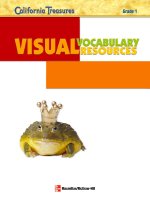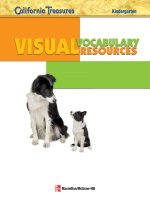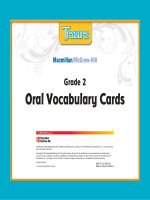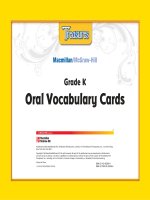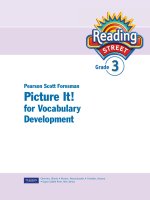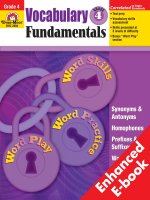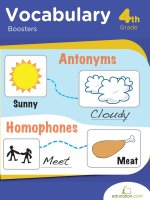treasures oral vocabulary cards grade 2
Bạn đang xem bản rút gọn của tài liệu. Xem và tải ngay bản đầy đủ của tài liệu tại đây (17.33 MB, 247 trang )
Grade 2
Oral Vocabulary Cards
Macmillan/McGraw-Hill
A
Published by Macmillan/McGraw-Hill, of McGraw-Hill Education, a division of The McGraw-Hill Companies, Inc., Two Penn Plaza,
New York, New York 10121.
Copyright © by Macmillan/McGraw-Hill. All rights reserved. No part of this publication may be reproduced or distributed in
any form or by any means, or stored in a database or retrieval system, without the prior written consent of The McGraw-Hill
Companies, Inc., including, but not limited to, network storage or transmission, or broadcast for distance learning.
Printed in China
1 2 3 4 5 6 7 8 9 10 DSS 12 11 10 9 8
ISBN 10: 0-02-202029-2
ISBN 13: 978-0-02-202029-3
What Goat Learned
The Three Friends
The Story of the Donkey
The Nightingale
The Statue of Liberty
Two Brothers
The Scent of Bread
How Coyote Stole Fire
John Henry
Daedalus and Icarus
The Powwow: A Native American
Celebration
La Cucarachita Martina Gets Married
Spider Woman Teaches the Navajo
How to Weave
On the Farm
How Anansi Brought Stories to Earth
The Enormous Yuca
Tikki Tikki Tembo
Little Red Riding Hood
The Woman, the Tiger, and the Jackal
The Emperor’s New Clothes
Jack and the Beanstalk
Brer Rabbit in Mr. Man’s Garden
Sharks!
From Tadpole to Frog
Coral Reefs
The Desert Is Their Home
The Fox and the Crane
Febold Feboldson, Drought Buster
The Stonecutter
Why the Moon Is in the Sky
Table of Contents
E
L
L
G
e
n
e
r
a
t
e
S
y
n
o
n
y
m
s
S
a
y
:
G
o
a
t
i
s
e
a
g
e
r
t
o
l
e
a
r
n
t
o
c
l
i
m
b
.
W
h
e
n
y
o
u
r
e
a
l
l
y
,
r
e
a
l
l
y
w
a
n
t
t
o
d
o
s
o
m
e
t
h
i
n
g
,
h
o
w
d
o
y
o
u
f
e
e
l
?
W
h
a
t
w
o
r
d
s
m
e
a
n
a
l
m
o
s
t
t
h
e
s
a
m
e
a
s
e
a
g
e
r
?
W
h
o
a
re
y
o
u
r
t
e
a
c
h
e
rs
?
W
h
a
t
d
o
y
o
u
le
a
r
n
f
r
o
m
th
e
m
?
W
h
a
t
w
o
u
ld
h
a
p
p
e
n
if
y
o
u
s
t
o
p
p
e
d
lis
t
e
n
in
g
to
th
e
m
?
L
o
n
g
, lo
n
g
a
g
o
, w
h
e
n
t
h
e
la
n
d
w
a
s
n
e
w
a
n
d
a
ll
th
e
a
n
im
a
ls
w
e
r
e
f
re
e
t
o
d
o
a
s
t
h
e
y
w
is
h
e
d
, C
a
t
a
n
d
G
o
a
t w
e
r
e
g
o
o
d
frie
n
d
s
. T
h
e
y s
p
e
n
t
t
h
e
ir d
a
y
s
t
o
g
e
t
h
e
r
e
x
p
lo
rin
g
t
h
e
g
r
e
e
n
fo
r
e
s
t
s
a
n
d
h
ig
h
m
o
u
n
t
a
in
s
o
f
t
h
e
ir
b
e
a
u
t
if
u
l isla
n
d
h
o
m
e
.
I
t
w
a
s
d
u
ri
n
g
t
h
e
ir
t
ra
v
e
ls
t
h
a
t
G
o
a
t
b
e
g
a
n
t
o
n
o
tic
e
th
e
w
a
y
t
h
a
t
C
a
t
m
o
v
e
d
. G
o
a
t
w
a
s
lo
u
d
a
n
d
c
lu
m
s
y
, b
u
t
C
a
t
c
o
u
ld
c
re
e
p
qu
ie
t
ly
a
lo
n
g
t
h
e
f
o
re
s
t
fl
o
o
r
. C
a
t
c
o
u
ld
le
a
p
g
r
a
c
e
fu
lly
f
r
o
m
r
o
c
k
t
o
ro
c
k
. A
n
d
b
e
s
t
o
f a
ll
, C
a
t
c
o
u
ld
c
lim
b
h
ig
h
in
t
o
t
h
e
t
a
ll
g
re
e
n
tr
e
e
s
. In
f
a
c
t
, C
a
t
m
a
d
e
c
lim
b
in
g
t
re
e
s
lo
o
k
li
k
e
s
o
m
u
c
h
fu
n
, G
o
a
t
w
a
s
e
a
g
e
r
t
o
t
ry
it
h
im
s
e
lf
.
“
C
a
t
,” s
a
id
G
o
a
t, “
y
o
u
a
re
a
n
e
x
p
e
rt
a
t
c
lim
b
in
g
t
re
e
s. W
il
l y
o
u
t
e
a
c
h
m
e
t
o
c
lim
b
, t
o
o
?
”
C
a
t
a
g
re
e
d
.
W
h
a
t G
o
a
t L
e
a
rn
e
d
A
T
a
l
e
f
r
o
m
H
a
i
t
i
©
M
a
c
m
i
l
l
a
n
/
M
c
G
r
a
w
-
H
i
l
l
•
i
l
l
u
s
t
r
a
t
i
o
n
b
y
O
l
e
y
n
i
k
o
v
“
W
h
a
t
G
o
a
t
L
e
a
r
n
e
d
”
a
p
p
e
a
r
s
a
s
“
T
h
e
E
d
u
c
a
t
i
o
n
o
f
G
o
a
t
”
i
n
T
h
e
S
i
n
g
i
n
g
T
u
r
t
l
e
a
n
d
o
t
h
e
r
t
a
l
e
s
f
r
o
m
H
a
i
t
i
b
y
P
h
i
l
i
p
p
e
T
h
o
b
y
-
M
a
r
c
e
l
i
n
a
n
d
P
i
e
r
r
e
M
a
r
c
e
l
i
n
,
F
a
r
r
a
r
,
S
t
r
a
u
s
&
G
i
r
o
u
x
,
I
n
c
.
1
9
7
1
.
T
r
a
n
s
l
a
t
e
d
f
r
o
m
C
o
n
t
e
e
t
L
e
g
e
n
d
e
s
d
’
H
a
i
t
i
,
1
9
6
7
F
e
r
n
a
n
d
N
a
t
h
a
n
a
n
d
P
h
i
l
i
p
p
e
T
h
o
b
y
-
M
a
r
c
e
l
i
n
e
t
P
i
e
r
r
e
M
a
r
c
e
l
i
n
.
T
h
i
s
a
d
a
p
t
a
t
i
o
n
i
s
r
e
p
r
i
n
t
e
d
w
i
t
h
p
e
r
m
i
s
s
i
o
n
o
f
F
a
r
r
a
r
,
S
t
r
a
u
s
&
G
i
r
o
u
x
.
O
r
a
l
V
o
c
a
b
u
l
a
r
y
e
a
g
e
r
D
e
fi
n
e
:
A
n
e
a
g
e
r
p
e
r
s
o
n
w
a
n
t
s
t
o
d
o
s
o
m
e
t
h
i
n
g
v
e
r
y
m
u
c
h
.
E
x
a
m
p
l
e
:
B
o
b
i
s
e
a
g
e
r
t
o
g
o
t
o
t
h
e
b
e
a
c
h
t
h
i
s
s
u
m
m
e
r
.
A
s
k
:
W
h
a
t
a
r
e
y
o
u
e
a
g
e
r
t
o
d
o
t
h
i
s
w
e
e
k
e
n
d
?
e
xpe
rt
D
e
fi
n
e
:
A
n
e
x
p
e
r
t
k
n
o
w
s
a
l
o
t
a
b
o
u
t
s
o
m
e
t
h
i
n
g
o
r
c
a
n
d
o
s
o
m
e
t
h
i
n
g
v
e
r
y
w
e
l
l
.
E
x
a
m
p
l
e
:
A
fi
r
e
fi
g
h
t
e
r
i
s
a
n
e
x
p
e
r
t
a
t
r
e
s
c
u
i
n
g
p
e
o
p
l
e
.
A
s
k
:
W
h
o
a
r
e
s
o
m
e
e
x
p
e
r
t
s
i
n
y
o
u
r
n
e
i
g
h
b
o
r
h
o
o
d
?
W
h
a
t
d
o
t
h
e
y
d
o
?
A
d
d
i
t
i
o
n
a
l
V
o
c
a
b
u
l
a
r
y
R
e
r
e
a
d
t
h
e
s
e
l
e
c
t
i
o
n
.
I
n
t
r
o
d
u
c
e
t
h
e
u
n
d
e
r
l
i
n
e
d
w
o
r
d
s
u
s
i
n
g
t
h
e
v
o
c
a
b
u
l
a
r
y
r
o
u
t
i
n
e
o
n
H
o
w
t
o
U
s
e
t
h
e
O
r
a
l
V
o
c
a
b
u
l
a
r
y
C
a
r
d
s
.
1
N
2
C
R
D
OV_F
L_
U
1W
1_R
D
0
9.i
n
dd
1
N2CRD
OV_FL_U
1W1_RD09.in
dd
1
2
/
12
/07
1
1:2
2:
1
6
AM
O
r
a
l
V
o
c
a
b
u
l
a
r
y
E
L
L
W
h
a
t
i
s
a
c
o
r
a
l
r
e
e
f
?
W
h
e
r
e
w
o
u
l
d
y
o
u
s
e
e
o
n
e
?
W
h
a
t
w
o
u
l
d
y
o
u
l
i
k
e
t
o
l
e
a
r
n
a
b
o
u
t
c
o
r
a
l
r
e
e
f
s
?
C
o
r
a
l
r
e
e
f
s
a
r
e
b
u
s
y
u
n
d
e
r
w
a
t
e
r
p
l
a
c
e
s
w
h
e
r
e
m
a
n
y
c
o
l
o
r
f
u
l
a
n
i
m
a
l
s
a
n
d
p
l
a
n
t
s
l
i
v
e
.
S
o
m
e
p
e
o
p
l
e
t
h
i
n
k
c
o
r
a
l
r
e
e
f
s
a
r
e
m
a
d
e
o
f
r
o
c
k
s
o
r
s
h
e
l
l
s
,
b
u
t
t
h
a
t
’
s
n
o
t
s
o
.
C
o
r
a
l
r
e
e
f
s
a
r
e
a
c
t
u
a
l
l
y
m
a
d
e
u
p
o
f
t
i
n
y
l
i
v
i
n
g
c
r
e
a
t
u
r
e
s
c
a
l
l
e
d
c
o
r
a
l
p
o
l
y
p
s
.
T
h
e
s
e
a
n
i
m
a
l
s
a
r
e
o
n
l
y
a
b
o
u
t
1
/
4
i
n
c
h
a
c
r
o
s
s
.
I
t
t
a
k
e
s
m
i
l
l
i
o
n
s
o
f
c
o
r
a
l
p
o
l
y
p
s
t
o
m
a
k
e
o
n
e
r
e
e
f
.
D
i
f
f
e
r
e
n
t
p
o
l
y
p
s
f
o
r
m
d
i
f
f
e
r
e
n
t
k
i
n
d
s
o
f
c
o
r
a
l
.
C
o
r
a
l
c
a
n
b
e
m
a
n
y
d
i
f
f
e
r
e
n
t
c
o
l
o
r
s
.
I
t
c
a
n
b
e
i
n
t
e
r
e
s
t
i
n
g
s
h
a
p
e
s
a
n
d
s
i
z
e
s
,
t
o
o
.
C
o
r
a
l
r
e
e
f
s
a
r
e
l
o
c
a
t
e
d
i
n
w
a
r
m
,
s
h
a
l
l
o
w
w
a
t
e
r
,
u
s
u
a
l
l
y
n
e
a
r
l
a
n
d
.
T
h
e
b
i
g
g
e
s
t
c
o
r
a
l
r
e
e
f
i
n
t
h
e
w
o
r
l
d
i
s
A
u
s
t
r
a
l
i
a
’
s
G
r
e
a
t
B
a
r
r
i
e
r
R
e
e
f
.
T
h
e
G
r
e
a
t
B
a
r
r
i
e
r
R
e
e
f
i
s
a
b
o
u
t
1
,
2
6
0
m
i
l
e
s
l
o
n
g
!
C
o
ral R
e
e
fs
©
M
a
c
m
i
l
l
a
n
/
M
c
G
r
a
w
-
H
i
l
l
p
h
o
t
o
©
C
o
m
s
t
o
c
k
I
m
a
g
e
s
/
P
i
c
t
u
r
e
Q
u
e
s
t
l
o
c
a
t
e
d
D
e
fi
n
e
:
W
h
e
n
y
o
u
t
e
l
l
w
h
e
r
e
s
o
m
e
t
h
i
n
g
i
s
l
o
c
a
t
e
d
,
y
o
u
t
e
l
l
w
h
e
r
e
i
t
i
s
f
o
u
n
d
.
E
x
a
m
p
l
e
:
O
u
r
s
c
h
o
o
l
i
s
l
o
c
a
t
e
d
o
n
P
i
n
e
S
t
r
e
e
t
,
n
e
x
t
t
o
t
h
e
p
a
r
k
.
A
s
k
:
W
h
e
r
e
i
s
y
o
u
r
h
o
u
s
e
l
o
c
a
t
e
d
?
U
s
e
P
h
o
t
o
g
r
a
p
h
s
H
e
l
p
s
t
u
d
e
n
t
s
u
s
e
t
h
e
p
h
o
t
o
g
r
a
p
h
t
o
d
e
s
c
r
i
b
e
a
c
o
r
a
l
r
e
e
f
.
A
s
k
:
W
h
a
t
c
o
l
o
r
i
s
t
h
i
s
c
o
r
a
l
r
e
e
f
?
W
h
a
t
d
o
e
s
t
h
e
c
o
r
a
l
l
o
o
k
l
i
k
e
t
o
y
o
u
?
G
u
i
d
e
s
t
u
d
e
n
t
s
t
o
c
o
m
p
a
r
e
t
h
e
c
o
r
a
l
t
o
o
t
h
e
r
t
h
i
n
g
s
:
T
h
e
c
o
r
a
l
l
o
o
k
s
l
i
k
e
_
_
_
_
_
_
.
A
d
d
i
t
i
o
n
a
l
V
o
c
a
b
u
l
a
r
y
R
e
r
e
a
d
t
h
e
s
e
l
e
c
t
i
o
n
.
I
n
t
r
o
d
u
c
e
t
h
e
u
n
d
e
r
l
i
n
e
d
w
o
r
d
s
u
s
i
n
g
t
h
e
v
o
c
a
b
u
l
a
r
y
r
o
u
t
i
n
e
o
n
H
o
w
t
o
U
s
e
t
h
e
O
r
a
l
V
o
c
a
b
u
l
a
r
y
C
a
r
d
s
.
1
N
2
C
R
D
O
V
_
F
L
_
U
4
W
5
_
R
D
0
9.
i
n
d
d
1
2
/8
/0
7
1
:
3
0
:3
8
P
M
2/8/07 1:30
:38 PM
How to Use the Oral Vocabulary Cards
Key Features of the
Oral Vocabulary Cards
• The Oral Vocabulary Cards feature folk tales from
around the world and high-interest nonfiction. There
is one set of four cards for each selection/per week.
• Every card has a full-color illustration or photo on
the front. The images can be shown while reading
the text aloud. They can be used to reinforce the
Wonderful Words and additional words. These words
build children’s oral vocabularies beyond their reading
vocabularies. A minimum of ten words are included in
each selection.
• A Wonderful Words section provides a routine for
introducing new vocabulary. Introduce highlighted
words using the following routine:
Define: offers a student-friendly definition
Example: uses the word in a context children will
relate to
Ask: offers a question that requires children to apply
the word in their own sentences as they reply
• Additional Vocabulary Words are provided for more
vocabulary opportunities. Introduce the underlined
vocabulary using the Define/Example/Ask routine.
• English Learner (EL) strategies help unlock the
meanings of words through engaging activities for all
children.
• A Retelling feature helps children use the illustrations
and photographs to retell the events and facts.
Using the Oral Vocabulary Cards
While You Read
• Use the focus questions before the selection to start
a discussion with children before reading. Evaluate
children’s prior knowledge of the concepts introduced
in the story and use the discussion to build children’s
background.
• Read the selection aloud, engaging children by
pointing out key elements of the illustrations or
photos that help make the text comprehensible. As
you encounter a highlighted word, stop and use the
Define/Example/Ask routine to teach the word and
provide time for discussion.
• As an alternative, first read the selection straight
through and then go back to use the Define/Example/
Ask routine to teach the Wonderful Words.
Using the Oral Vocabulary Cards
Guided Rereading
On a subsequent reading, use the same Define/Example/
Ask routine to teach the underlined additional vocabulary
words. Use the EL strategies if you have not already done
so. Use language frames and sentence starters so children
have a context in which to supply vocabulary words.
Encourage them to echo the sentences when the frames
are complete.
Retelling
Do a Modeled Retelling of the selection by holding up
each card and talking about what you see as you ask
children questions found in the Retell box.
For example, for “What Goat Learned,” a Haitian tale,
retell the story as follows:
Card 1: Long ago, Cat and Goat were good friends. Goat
wanted to learn how to climb trees the way Cat did. So he
asked Cat to teach him how.
Card 2: Goat tried hard to climb the tree like Cat, but
he could not get his back legs off the ground. Cat
encouraged him to keep trying.
Card 3: Later, Cat found Goat teaching Dog how to
climb a tree. But Cat did not want Dog to learn how to
climb trees. Now, Cat knew that Goat had never finished
learning how to climb, and so would not be able to teach
Dog. So Cat said that he would not be Goat’s teacher
anymore.
Card 4: Goat and Dog kept trying to climb the tree, but
they couldn’t. Cat watched from a tree branch. She was
happy, because she knew that without her as a teacher,
neither Goat nor Dog would ever learn to climb a tree.
Developing Conversations
The Oral Vocabulary Cards are linked to the weekly and
unit themes. They are designed to develop children’s
listening and speaking skills. As you share the stories with
children, use the following strategies to engage children
in independent and group responses.
• Motivate discussion by asking children about their
experiences. Use the focus questions at the beginning
of each selection. Discuss unfamiliar concepts by
relating to children’s personal experiences. Use
examples from your own life to make concepts clear.
• Pause long enough to allow children to think and
respond.
• Ask children, one by one, to retell the events of the
story in a group situation. Encourage each child to tell
one event or fact in chronological order.
• Practice fluency with the patterned parts and repetitive
stanzas.
• Have children role-play the parts of the story by
becoming characters. Have a narrator tell the story
while children use the characters’ words at the
appropriate time. Allow groups of children to become
one character so that children at a beginning language
level can participate.
• Provide a simple synopsis of the story and invite
children to add the details they remember.
Intensive Vocabulary Instruction
For children needing additional vocabulary
development, follow the Intensive Vocabulary
5-Day Plan below. Spend 15-20 minutes a day providing
targeted vocabulary instruction and practice using
the Oral Vocabulary Cards.
Intensive Vocabulary 5-Day Plan
Day 1: Review the previous week’s words. Then
administer the Oral Vocabulary Pretest in the
Teacher’s Resource Book. If time allows, read the
selection aloud for enjoyment and prompt children to
offer personal responses.
Day 2: Read the selection and teach the highlighted
words using the Define/Example/Ask routines
provided.
Day 3: Reread the selection and teach the underlined
words using the Define/Example/Ask routine.
Day 4: Revisit the selection, review the vocabulary
words, and guide children in a retelling.
Day 5: Administer the Oral Vocabulary Posttest in the
Teacher’s Resource Book. Allow time for children to
independently retell the selection. Prompt them to
use the new vocabulary taught by providing sentence
frames or sentence starters.
Periodic Review
Once a set of words has been taught, continue to
review the words throughout the upcoming weeks.
Children will need several weeks of continuous review
to master many of these words. To provide ample
review:
• Review the previous week’s words at the beginning of
each new week.
• Incorporate the new words into classroom
discussions. Rephrase children’s responses, when
appropriate, to use new words. Ask children to repeat.
• Use the new words in transition activities. For
example, ask children to name a time they were
exhausted as they line up for recess, one by one.
• At the end of the each unit, revisit all the Oral
Vocabulary Card stories for that unit. State a targeted
vocabulary word, and ask children to use it in a
sentence that tells about a story or something they
learned in that unit.
• Send home the list of vocabulary words taught and
sentence starters for families to engage their children
in discussions using the words.
Academic Language
Many children struggle in school due to their limited
knowledge and use of academic language. Academic
words include those harder Tier 2 words that appear
in much of children’s reading materials as well as the
language of instruction.
Tier 1 Words: Everyday words (cat, apple, table)
Tier 2 Words: Academic words (exhausted, analyze,
majority)
Tier 3 Words: Content specific words (lava,
Louisiana Purchase, viceroy)
The words chosen for instruction on the Oral
Vocabulary Cards were carefully sequenced and
selected by consulting three sources: (1) the Living Word
Vocabulary list, (2) Avril Coxhead’s list of High-Incidence
Academic Words, and (3) Andrew Biemiller’s Words
Worth Teaching list.
English Learners
Who are your teachers? What do you learn from them? What would
happen if you stopped listening to them?
Long, long ago, when the land was new and all the animals were
free to do as they wished, Cat and Goat were good friends. They spent
their days together exploring the green forests and high mountains of
their beautiful island home.
It was during their travels that Goat began to notice the way that
Cat moved. Goat was loud and clumsy, but Cat could creep quietly
along the forest fl oor. Cat could leap gracefully from rock to rock. And
best of all, Cat could climb high into the tall green trees. In fact, Cat
made climbing trees look like so much fun, Goat was eager to try it
himself.
“Cat,” said Goat, “you are an expert at climbing trees. Will you
teach me to climb, too?” Cat agreed.
What Goat Learned
A Tale from Haiti
©Macmillan/McGraw-Hill • illustration by Oleynikov
“What Goat Learned” appears as “The Education of Goat” in The Singing Turtle and other tales from Haiti by Philippe Thoby-Marcelin and Pierre Marcelin, Farrar, Straus & Giroux, Inc. 1971.
Translated from Conte et Legendes d’Haiti, 1967 Fernand Nathan and Philippe Thoby-Marcelin et Pierre Marcelin. This adaptation is reprinted with permission of Farrar, Straus & Giroux.
Oral
Vocabulary
eager
Defi ne: An eager person wants
to do something very much.
Example: Bob is eager to go to
the beach this summer.
Ask: What are you eager to do
this weekend?
expert
Defi ne: An expert knows a lot
about something or can do
something very well.
Example: A fi refi ghter is an
expert at rescuing people.
Ask: Who are some experts in
your neighborhood? What do
they do?
Intensive Vocabulary Support Reread the selection. Introduce the underlined words
using the vocabulary routine on How to Use the Oral Vocabulary Cards.
Generate Synonyms Say: Goat
is eager to learn to climb.
When you really, really want
to do something, how do you
feel? What words mean almost
the same as eager
?
1
Vocabulary
UNIVERSAL ACCESS
English Learners
Now, climbing trees was not something that came naturally to Goat.
Oh, no! After all, Goat did not have claws for digging into tree trunks.
He did not have a long tail for balance. He was not quick, and he was
not graceful. But with Cat’s help, Goat made progress.
Clat-a-tat-tat! Clat-a-tat-tat! As Cat watched, Goat’s front hooves
clattered up a tree trunk. Clat-a-tat-tat! Clat-a-tat-tat! Goat’s front legs
reached higher and higher while his back legs stayed on the ground.
After a few attempts , Goat was able to stretch his front legs halfway
up the trunk. He could even reach the lowest branches and nibble on
the tasty green leaves.
“Keep going!” cried Cat. “Don’t give up! As my grandfather used to
say: ‘With patience, even an ant can climb a mountain!’”
So Goat kept trying. But try as he may, Goat’s back legs never came
off the ground.
attempt
Defi ne: An attempt is a try.
Example: Justin made an
attempt to build his model
airplane.
Ask: Why is it important not
to quit if your fi rst attempt at
something doesn’t work out?
What Goat Learned
©Macmillan/McGraw-Hill
illustration by Oleynikov
Compare and Contrast Say:
Cat and Goat are good friends,
and they both walk on all
fours. But Cat is a much better
climber. Why? How is Cat
different from Goat?
2
English Learners
One fi ne morning not long after this, Cat went to fi nd his friend
Goat. He saw Goat beside a tree, talking to Dog.
“Watch closely, Dog, and do what I do,” said Goat. Then he lifted
his front hooves onto the tree trunk. Clat-a-tat-tat! Clat-a-tat-tat! Goat
was teaching Dog everything he’d learned about how to climb a tree.
Now Cat knew that if Dog learned how to climb, there would be
real trouble in the trees! A cat like her would have no safe place to go.
But Cat also knew that Goat had never really fi nished his lessons so he
didn’t yet know how to climb a tree.
“Goat,” said Cat with a clever smile, “I see that you have become a
teacher! There is nothing more you can learn from me. Good luck!”
©Macmillan/McGraw-Hill
illustration by Oleynikov
©Macmillan/McGraw-Hill
illustration by Oleynikov
What Goat Learned
Oral
Vocabulary
lesson
Defi ne: In a lesson, a teacher
teaches a skill to a student.
Example: During Jane’s piano
lesson, the teacher shows her
how to play new songs.
Ask: What kind of lessons
would you like to take?
Paraphrase Say: Goat is
teaching Dog how to climb a
tree. But Cat doesn’t want Dog
to know how to climb trees!
Why doesn’t Cat want Dog
to climb trees? What does
Cat do?
33
Vocabulary
Retell
And with that, Cat climbed the tree and stretched out on a high
branch, watching what was going on below. Goat and Dog continued
to take turns trying to climb the tree. Again and again, they stretched
their front legs up the trunk as high as they could. But their back legs
never left the ground.
“Without me as a teacher,” thought Cat, “Goat will never have
the knowledge to climb trees. And if Goat doesn’t learn how to climb
trees, he can’t teach Dog how to climb either. I am safe up here,
indeed!”
And that is why Goat never completed his lessons with Cat. And
that is why Goat never learned to climb to the top of a tree, and
neither did Dog.
Clat-a-tat-tat! Clat-a-tat-tat!
knowledge
Defi ne: Knowledge is
information, or what
someone knows.
Example: Danny used his great
knowledge of dinosaurs to
write a report.
Ask: What kind of knowledge
does a doctor need?
What Goat Learned
©Macmillan/McGraw-Hill
illustration by Oleynikov
Help children use the
pictures to retell the story.
Card 1: What does Goat
want to learn how to do?
Why does he think Cat
would be a good teacher?
Card 2: Why is it hard for
Goat to climb to the top of
the tree? What advice does
Cat offer?
Card 3: What is Goat saying
to Dog? Why doesn’t Cat
want Dog to learn to climb
trees?
Card 4: What is Cat’s plan?
Why doesn’t Goat ever learn
to climb trees?
4
What could they do together? How could they help each other?
Once upon a time, three friends lived by a lake. Deer lived in the
woods near the lake. Woodpecker lived in a tree next to the lake. And
Turtle made his home in the mud at the edge of the very same lake.
The three were very fond of each other and spent their days happily
playing.
One day, a hunter came to the lake. Seeing Deer’s footprints, he
said, “I will set a trap to catch this deer!” He put out a strong leather
trap and then went home.
That very evening Deer stepped into the trap. “My friends!” he cried
out. “I am caught fast in this trap!”
The Three Friends
A Tale from India
©Macmillan/McGraw-Hill
illustration by Alessia Girasole
Oral
Vocabulary
fond
Defi ne: Fond of means to like
a lot.
Example: I am fond of my pets.
Ask: What are some things that
you are fond of?
Intensive Vocabulary Support Reread the selection. Introduce the underlined words
using the vocabulary routine on How to Use the Oral Vocabulary Cards.
UNIVERSAL ACCESS
English Learners
Identify Story Elements Ask
children to identify the setting
of the story. Ask: Does it look
like a place where you have
been? In what way? Help
children name the animals,
the lake, the trees, and other
features in the setting.
1
Vocabulary
companion
Defi ne: A companion is
someone whom you spend
time with.
Example: My companion and I
play together every day.
Ask: Do you have a companion
you like to spend time with?
What do you like to do
together?
The Three Friends
©Macmillan/McGraw-Hill
illustration by Alessia Girasole
agree
Defi ne: When you agree with
someone, you have the same
idea about something.
Example: Mario and Kim agree
that cats are wonderful pets.
Ask: What are some things you
and your friends agree about?
Woodpecker and Turtle heard their companion’s cry. Woodpecker
fl ew down from her treetop. Turtle hurried out of the water. They saw
Deer trapped by the leather straps.
“We must fi nd a way to help our friend!” cried Woodpecker.
“I agree ,” said Turtle. “My teeth are as sharp as a saw. I will use
them to cut the straps.”
“And I will fl y to the hunter’s hut,” said Woodpecker. “I will keep
him away until you cut through the straps.”
All night long, Turtle worked on the straps with his teeth.
“Thank you, my kind friend,” said Deer trembling.
Turtle smiled up at Deer and then continued to work.
Meanwhile, Woodpecker waited at the hunter’s hut. In the morning,
the hunter came out the front door. Woodpecker gave a loud cry and
fl apped her wings wildly at him.
“What is that!?” cried the hunter, hurrying back inside. Next, the
hunter came out the back door. But Woodpecker was waiting for
him. She fl ew at him and fl apped her wings frantically. Once again
the hunter rushed back inside. But the third time, the hunter ran past
Woodpecker.
UNIVERSAL ACCESS
English Learners
Words with Multiple
Meanings Say: Turtle and
Woodpecker saw that Deer
was trapped. What does saw
mean here? (used their eyes to
see) Turtle says his teeth are as
sharp as a saw. What does saw
mean here? (a tool that cuts)
Use saw in sentences to show
both meanings.
2
hunter is coming!” she warned them.
By this time, Turtle had bitten through all the straps but one. The
leather was hard, and Turtle was very tired. “I don’t think I can do it,”
thought Turtle. But he was a loyal friend and did not give up.
Then Deer saw the hunter coming through the forest. “There is no
more time!” he cried. And using all his strength, Deer broke the last
strap and ran off as fast as he could.
Woodpecker swiftly fl ew up to her nest in the treetop. But Turtle
was so weak that he could not crawl away. He lay quietly where he
was.
When the hunter saw Turtle and the broken trap, he said, “I have
lost the deer, but at least I will have this turtle.” With that, he picked
Turtle up, put him in a cloth bag, and tied the bag up tight.
©Macmillan/McGraw-Hill
illustration by Alessia Girasole
The Three Friends
Oral
Vocabulary
loyal
Defi ne: A loyal friend is a friend
you can count on.
Example: My dog is a loyal
companion to me.
Ask: What makes you a loyal
companion to your friends?
UNIVERSAL ACCESS
English Learners
Make Predictions Ask: Do you
think Deer and Woodpecker
will save Turtle? What could
they do?
33
Vocabulary
Deer saw that his friend Turtle was in trouble. “I appreciate how
Turtle saved my life,” he said. “Now I must do the same for him!” So
Deer stepped into the open to let the hunter see him.
“Now I will get you, Deer,” cried the hunter. He hung the cloth bag
with Turtle in it on a tree and chased after Deer.
Down fl ew Woodpecker. She pecked a hole in the bag. “Jump out,
Turtle!” she said.
“It’s too far to jump,” cried Turtle. “My shell will break!”
By this time, Deer had led the hunter far into the forest. Then, swift
as the wind, he turned and galloped back to Turtle. With his long
horns, Deer lifted the bag down from the tree and put it on the grass.
Turtle crept out through the hole that Woodpecker had made.
When the hunter returned, all he found was his torn bag.
Deer, Woodpecker, and Turtle had gone to the other side of the
lake. There the three loyal friends and companions lived happily for the
rest of their lives.
appreciate
Defi ne: When you appreciate
something, you are grateful
for it.
Example: I appreciate it when
my brother helps me do my
chores.
Ask: What has someone done
that you appreciate?
Help children use the
pictures to retell the story.
Card 1: Who are the main
characters in this story?
What is the setting? What
is the problem?
Card 2: How does Turtle
try to help Deer? How does
Woodpecker try to help?
Why do you think they try
to help Deer?
Card 3: What does Deer
do when he sees the
hunter coming back? What
happens to Turtle?
Card 4: How does Deer
help Turtle? How does
Woodpecker help? How do
you know that the animals
are the best of friends?
Retell
The Three Friends
©Macmillan/McGraw-Hill
illustration by Alessia Girasole
4
Oral
Vocabulary
UNIVERSAL ACCESS
English Learners
Intensive Vocabulary Support Reread the selection. Introduce the underlined words
using the vocabulary routine on How to Use the Oral Vocabulary Cards.
The Story of the Donkey
Based on a Fable by Aesop
What kinds of activities do you enjoy doing with family members
such as aunts, uncles, and grandparents? What have you learned
from them?
Long ago, a girl named Anna lived with her parents and grandfather.
Anna and Grandfather had a special relationship . He liked to tell her
stories, and he taught her how to play the games that he played as
a boy. But their bond became even stronger when they took a trip
together. This is the story of what happened on that journey.
One day, the family decided it was time to sell their donkey.
Grandfather volunteered to take the donkey to market, and Anna
wanted to go with him. So early the next morning, they set off for the
market with the donkey following behind.
The two had been walking for a little while, when they met a man
who was chopping wood. “Why are you both walking?” he asked.
“One of you should be riding. How foolish you are!”
relationship
Defi ne: A relationship is a
connection between people.
Example: James has a close
relationship with his brother.
They love to play sports
together.
Ask: What family member do
you have a close relationship
with? What do you do
together?
bond
Defi ne: A bond is a feeling
of understanding that holds
people together.
Example: Beth and Sarah share
a bond because they’ve been
friends since kindergarden.
Ask: With what friend do you
have a strong bond? What
made the bond strong?
Compose Sentences Say:
Grandfather volunteered to
take the donkey to market.
What do you volunteer to do
at school? Have children fi nish
this sentence: At home, I
volunteer to ______.
©Macmillan/McGraw-Hill
illustration by John Hovell
1
